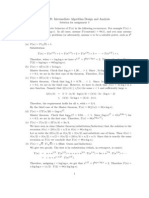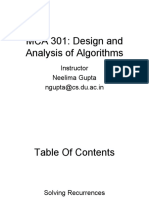Fundamental Algorithms, Assignment 4 Solutions
Fundamental Algorithms, Assignment 4 Solutions
Uploaded by
Aashish DCopyright:
Available Formats
Fundamental Algorithms, Assignment 4 Solutions
Fundamental Algorithms, Assignment 4 Solutions
Uploaded by
Aashish DOriginal Title
Copyright
Available Formats
Share this document
Did you find this document useful?
Is this content inappropriate?
Copyright:
Available Formats
Fundamental Algorithms, Assignment 4 Solutions
Fundamental Algorithms, Assignment 4 Solutions
Uploaded by
Aashish DCopyright:
Available Formats
Fundamental Algorithms, Assignment 4
Solutions
1. Consider the recursion T (n) = 9T (n/3) + n2 with initial value T (1) =
1. Calculate the precise values of T (3), T (9), T (27), T (81), T (243).
Make a good (and correct) guess as to the general formula for T (3i )
and write this as T (n). (Dont worry about when n is not a power
of three.) Now use the Master Theorem to give, in Thetaland, the
asymptotics of T (n). Check that the two answers are consistent.
Solution:T (3) = 9(1) + 33 = 18 = 2(9), T (9) = 9(18) + 92 = 243 =
3(81), T (27) = 9(243) + 729 = 2916 = 4(729), T (81) = 32805 =
5(6561), T (243) = 354294 = 6(59049). In general, T (3i ) = (i + 1)32i .
With n = 3i we have 32i = n2 and i = log3 n so the formula is
T (n) = n2 (1 + log3 n). In Thetaland, T (n) = (n2 lg n). With the
Master Theorem, as log3 9 = 2 we are in the special case which gives
indeed T (n) = (n2 lg n).
Another approach is via the auxilliary function S(n) discussed in class.
Here S(n) = T (n)/n2 . Dividing the original recursion by n2 gives
T (n) T (n/3)
2
= +1
n (n/3)2
so that
S(n) = S(n/3) + 1 with initial value S(1) = T (1)/12 = 1
so that
S(n) = 1 + log3 n and so T (n) = n2 (1 + log3 n)
2. Use the Master Theorem to give, in Thetaland, the asymptotics of
these recursions:
(a) T (n) = 6T (n/2) + n n
ln 6
Solution:As log2 6 = ln 2 = 2.58 > 3/2 we have Low Over-
head and T (n) = (n log 2 6 ).
(b) T (n) = 4T (n/2) + n5
Solution:log2 4 = 2 < 5 so we have High Overhead and T (n) =
(n5 ).
(c) T (n) = 4T (n/2) + 7n2 + 2n + 1
Solution:log2 4 = 2 and the Overhead is (n2 ) so T (n) =
(n2 lg n.
3. Toom-3 is an algorithm similar to the Karatsuba algorithm discussed in
class. (Dont worry how Toom-3 really works, we just want an analysis
given the information below.) It multiplies two n digit numbers by
making five recursive calls to multiplication of two n/3 digit numbers
plus thirty additions and subtractions. Each of the additions and
subtractions take time O(n). Give the recursion for the time T (n) for
Toom-3 and use the Master Theorem to find the asymptotics of T (n).
Compare with the time (nlog2 3 ) of Karatsuba. Which is faster when
n is large?
Solution:T (n) = 5T (n/3) + O(n) as the thirty is absorbed into the
big oh n term. From the master theorem T (n) = (nlog3 5 ). As
ln 5
log3 5 = = 1.46 < 1.58 = log2 3
ln 3
it is better that the (nlog2 3 ) of Karatsuba. (In practice unless n is
really large Karatsuba does better because Toom-3 has large constant
factors.)
4. Write the following sums in the form (g(n)) with g(n) one of the
standard functions. In each case give reasonable (they neednt be
optimal) positive c1 , c2 so that the sum is between c1 g(n) and c2 g(n)
for n large.
(a) n2 + (n + 1)2 + . . . + (2n)2
Solution:(n3). There are n terms all between n2 and 4n2
so the sum is between n3 (1 + o(1)) and 4n3 (1 + o(1)).
(b) lg2 (1) + lg2 (2) + . . . + lg2 (n)
Solution:(n lg2 n). There are n terms all at most lg2 (n) so
an upper bound is n lg2 (n). Lopping off the bottom half of the
terms we still have n/2 terms and each is at least lg2 (n/2) =
(lg(n) 1)2 lg2 n so the lower bound is (1 + o(1))( n2 ) lg2 n.
(c) 13 + . . . + n3 .
Solution:T (n) = (n4 ). Upper bound n4 as n terms, each at
most n. Lopping off bottom half yields n/2 terms, each at least
(n/2)3 giving a lower bound (n/2)(n/2)3 = n4 /16.
5. Give an algorithm for subtracting two n-digit decimal numbers. The
numbers will be inputted as A[0 N ] and B[0 N ] and the output
should be C[0 N ]. How long does your algorithm take, expressing
your answer in one of the standard (g(n)) forms.
Solution:Here is one way, the term BORROW being the truth value of
whether you have borrowed.
BORROW=false;
FOR I=0 TO N;
IF BORROW=false THEN X=A[I]-B[I];
IF BORROW=true THEN X=A[I]-1-B[I];
IF X 0 THEN
C[I]=X;
BORROW=false;
ELSE
C[I]=X+10;
BORROW=true;
ENDFOR
IF BORROW=true THEN ERROR;
END
This takes only a single pass and so is a linear time, that is (N )
algorithm.
You might also like
- A1 SolutionDocument5 pagesA1 SolutionGraciela MarquesNo ratings yet
- Recurrences and Methods For SolutionDocument44 pagesRecurrences and Methods For SolutionH Shamas Murtaza0% (1)
- Examen 2 Con Respuesta Ingles Grado OctavoDocument3 pagesExamen 2 Con Respuesta Ingles Grado OctavoManuela V RamosNo ratings yet
- Lecture3 PDFDocument15 pagesLecture3 PDFblackhatson13No ratings yet
- DAA Unit-2Document25 pagesDAA Unit-2Burra KotammaNo ratings yet
- Design A AlgorithmDocument20 pagesDesign A AlgorithmAyman AymanNo ratings yet
- hw1 SolnDocument7 pageshw1 SolnRudraraju Sai Vishnu VarmaNo ratings yet
- Fundamental Algorithms, Assignment 4: A B A BDocument2 pagesFundamental Algorithms, Assignment 4: A B A BAashish DNo ratings yet
- The Master Method and Its Use: Log A Ǫ Log ADocument2 pagesThe Master Method and Its Use: Log A Ǫ Log AvvvvickyNo ratings yet
- CMPS 101 Fall 2009 Homework Assignment 4 SolutionsDocument4 pagesCMPS 101 Fall 2009 Homework Assignment 4 SolutionshoshgeldyNo ratings yet
- Recurrence Tree Example PDFDocument10 pagesRecurrence Tree Example PDFAnkit KumarNo ratings yet
- 4 Recurrence and Master TheoremDocument37 pages4 Recurrence and Master TheoremHarshit RoyNo ratings yet
- Design and Analysis of AlgorithmDocument20 pagesDesign and Analysis of Algorithm2.8M views100% (1)
- Master Method RecurrencesDocument2 pagesMaster Method Recurrencesmirek12No ratings yet
- Recurrence Relations PDFDocument16 pagesRecurrence Relations PDFSrinivasaRao JJ100% (1)
- Ex 3 SolDocument3 pagesEx 3 SolNarbeh MirzaeiNo ratings yet
- Lecture 3Document15 pagesLecture 3werhmeisterNo ratings yet
- Divide and ConquerDocument4 pagesDivide and ConquerSaba SuhailNo ratings yet
- Unit 3 For ADADocument21 pagesUnit 3 For ADArutvik jobanputraNo ratings yet
- HW2 SolutionDocument8 pagesHW2 SolutiontilahunNo ratings yet
- CS 161 Summer 2009 Homework #2 Sample Solutions: Problem 1 (24 Points)Document8 pagesCS 161 Summer 2009 Homework #2 Sample Solutions: Problem 1 (24 Points)SrinivasaRao JJNo ratings yet
- 2-2 Methods For Solving RecurrenceDocument45 pages2-2 Methods For Solving RecurrenceRohan SrivastavaNo ratings yet
- CSCI 3110 Assignment 6 Solutions: December 5, 2012Document5 pagesCSCI 3110 Assignment 6 Solutions: December 5, 2012AdamNo ratings yet
- Recurrence Relation For Complexity Analysis of AlgorithmsDocument4 pagesRecurrence Relation For Complexity Analysis of AlgorithmsAwais ArshadNo ratings yet
- Divide and Conquer MethodologyDocument19 pagesDivide and Conquer Methodologythe477577No ratings yet
- RecurDocument7 pagesRecurPreethi PattabiramanNo ratings yet
- AlgorithmsDocument29 pagesAlgorithmsapdgt27No ratings yet
- RecurranceDocument25 pagesRecurranceJassi6SainiNo ratings yet
- Recurrence-Relations Time ComplexityDocument14 pagesRecurrence-Relations Time ComplexitySudharsan GVNo ratings yet
- Recurrence-Relations Time ComplexityDocument14 pagesRecurrence-Relations Time ComplexitySudharsan GVNo ratings yet
- Ad Endsem ImpDocument27 pagesAd Endsem Impanshuman tripathy-7008No ratings yet
- Divide Et Impera Si Programare DinamicaDocument64 pagesDivide Et Impera Si Programare Dinamicaprof.paul.enacheNo ratings yet
- Tutorial 3 SolutionsDocument3 pagesTutorial 3 SolutionsSaraNo ratings yet
- Alg Wk4aDocument26 pagesAlg Wk4a227567No ratings yet
- Divide and Conquer StrategyDocument10 pagesDivide and Conquer Strategyadityabaid4No ratings yet
- Asymptotic Analysis and RecurrencesDocument6 pagesAsymptotic Analysis and RecurrencesApoorv SemwalNo ratings yet
- RecurrencyDocument30 pagesRecurrencyAdam IbrahimNo ratings yet
- 4 - RecurrencesDocument4 pages4 - RecurrencesSMLNo ratings yet
- Some Document I Need To UploadDocument6 pagesSome Document I Need To UploadMr. XcoderNo ratings yet
- 5-Stages of Algorithm Development & Time Complexity Analysis-05-01-2024Document31 pages5-Stages of Algorithm Development & Time Complexity Analysis-05-01-2024vanchagargNo ratings yet
- CMSC 441: Homework #2 Solutions: Parag NamjoshiDocument3 pagesCMSC 441: Homework #2 Solutions: Parag Namjoshirakshitha NagendrappaNo ratings yet
- AP GP SummaryDocument21 pagesAP GP SummaryPng Poh ShengNo ratings yet
- Ada 3Document10 pagesAda 3Sunshine RatreyNo ratings yet
- Exercises #3 Solving Recurrences: Theoretical BackgroundDocument2 pagesExercises #3 Solving Recurrences: Theoretical BackgroundMarlon TugweteNo ratings yet
- Chapter 4: Recurrence Relations: Iterative and The Master MethodDocument19 pagesChapter 4: Recurrence Relations: Iterative and The Master MethodtilahunNo ratings yet
- Assignment - 1 - Solution - Updated On Oct 17Document9 pagesAssignment - 1 - Solution - Updated On Oct 17Maria GrizeldaNo ratings yet
- Section IV.5: Recurrence Relations From AlgorithmsDocument9 pagesSection IV.5: Recurrence Relations From AlgorithmsSam McGuinnNo ratings yet
- Proyecto ADADocument15 pagesProyecto ADAALEXANDERD JOSE SALAS FLORESNo ratings yet
- Data Structures and Algorithms: (CS210/ESO207/ESO211)Document22 pagesData Structures and Algorithms: (CS210/ESO207/ESO211)Moazzam HussainNo ratings yet
- Course Name: CS302-Design An Analysis of Algorithm: Credit Hours: 3Document83 pagesCourse Name: CS302-Design An Analysis of Algorithm: Credit Hours: 3f168002 Muhammad UmerNo ratings yet
- Some Properties of The Pseudo-Smarandache FunctionDocument6 pagesSome Properties of The Pseudo-Smarandache FunctionRyanEliasNo ratings yet
- CS3534 Operating Systems 18 42Document26 pagesCS3534 Operating Systems 18 42Cy Jay HerreraNo ratings yet
- Analysis of Algorithms: RecurrencesDocument32 pagesAnalysis of Algorithms: Recurrenceskalai2790No ratings yet
- Algorithm Complexity IDocument5 pagesAlgorithm Complexity Ixcr33d3493No ratings yet
- CSE 5311 Homework 1 Solution: Problem 2.2-1Document8 pagesCSE 5311 Homework 1 Solution: Problem 2.2-1tilahun0% (1)
- Contents of Table: A. RecurrenceDocument14 pagesContents of Table: A. RecurrenceByungwoo KimNo ratings yet
- Devide and Conqure RuleDocument11 pagesDevide and Conqure RuleAbhishek NandyNo ratings yet
- Anuj Thomas Mathew 1001237364Document2 pagesAnuj Thomas Mathew 1001237364Anuj MathewNo ratings yet
- MCA 301: Design and Analysis of Algorithms: Instructor Neelima Gupta Ngupta@cs - Du.ac - inDocument33 pagesMCA 301: Design and Analysis of Algorithms: Instructor Neelima Gupta Ngupta@cs - Du.ac - inEr Umesh ThoriyaNo ratings yet
- Fundamental Algorithms, Assignment 13Document2 pagesFundamental Algorithms, Assignment 13Aashish DNo ratings yet
- Fundamental Algorithms Midterm SolutionsDocument3 pagesFundamental Algorithms Midterm SolutionsAashish DNo ratings yet
- Fundamental Algorithms, Assignment 5 SolutionsDocument3 pagesFundamental Algorithms, Assignment 5 SolutionsAashish DNo ratings yet
- Fundamental Algorithms, Assignment 11Document4 pagesFundamental Algorithms, Assignment 11Aashish DNo ratings yet
- Fundamental Algorithms, Assignment 6 SolutionsDocument3 pagesFundamental Algorithms, Assignment 6 SolutionsAashish DNo ratings yet
- Fundamental Algorithms, Assignment ωDocument3 pagesFundamental Algorithms, Assignment ωAashish DNo ratings yet
- Fundamental Algorithms, Assignment 12Document4 pagesFundamental Algorithms, Assignment 12Aashish DNo ratings yet
- Midterm PDFDocument2 pagesMidterm PDFAashish DNo ratings yet
- Fundamental Algorithms, Assignment 13Document1 pageFundamental Algorithms, Assignment 13Aashish DNo ratings yet
- hw9 PDFDocument3 pageshw9 PDFAashish DNo ratings yet
- Fundamental Algorithms, Assignment 10Document2 pagesFundamental Algorithms, Assignment 10Aashish DNo ratings yet
- Fundamental Algorithms, Problem Set 2 SolutionsDocument4 pagesFundamental Algorithms, Problem Set 2 SolutionsAashish DNo ratings yet
- Fundamental Algorithms, Assignment 10 SolutionsDocument2 pagesFundamental Algorithms, Assignment 10 SolutionsAashish DNo ratings yet
- Fundamental Algorithms, Assignment 7 SolutionsDocument6 pagesFundamental Algorithms, Assignment 7 SolutionsAashish DNo ratings yet
- Fundamental Algorithms, Assignment 9 SolutionsDocument5 pagesFundamental Algorithms, Assignment 9 SolutionsAashish DNo ratings yet
- Fundamental Algorithms, Problem Set 3 SolutionsDocument5 pagesFundamental Algorithms, Problem Set 3 SolutionsAashish DNo ratings yet
- Fundamental Algorithms, Assignment 11Document2 pagesFundamental Algorithms, Assignment 11Aashish DNo ratings yet
- Fundamental Algorithms, Problem Set 1 SolutionsDocument3 pagesFundamental Algorithms, Problem Set 1 SolutionsAashish DNo ratings yet
- Fundamental Algorithms, Assignment 8Document3 pagesFundamental Algorithms, Assignment 8Aashish DNo ratings yet
- Fundamental Algorithms, Assignment 7 Due March 9/10 in RecitationDocument2 pagesFundamental Algorithms, Assignment 7 Due March 9/10 in RecitationAashish DNo ratings yet
- hw5 PDFDocument2 pageshw5 PDFAashish DNo ratings yet
- hw8 PDFDocument2 pageshw8 PDFAashish DNo ratings yet
- Fundamental Algorithms Final ExamDocument3 pagesFundamental Algorithms Final ExamAashish DNo ratings yet
- Fundamental Algorithms, Problem Set 2: Former Student, Now Big Cheese at GE HyderabadDocument1 pageFundamental Algorithms, Problem Set 2: Former Student, Now Big Cheese at GE HyderabadAashish DNo ratings yet
- Fundamental Algorithms Final ExamDocument2 pagesFundamental Algorithms Final ExamAashish DNo ratings yet
- Fundamental Algorithms, Problem Set 1 Not To Be SubmittedDocument1 pageFundamental Algorithms, Problem Set 1 Not To Be SubmittedAashish DNo ratings yet
- Fundamental Algorithms, Assignment 7Document2 pagesFundamental Algorithms, Assignment 7Aashish DNo ratings yet
- Fundamental Algorithms, Problem Set 3Document2 pagesFundamental Algorithms, Problem Set 3Aashish DNo ratings yet
- Personality Development Module #3 Assessment: Best Describes Each ItemDocument2 pagesPersonality Development Module #3 Assessment: Best Describes Each ItemAshierah MontasNo ratings yet
- Abraham, Sara (2003) An Ethnographic Study of Violence Experienced byDocument243 pagesAbraham, Sara (2003) An Ethnographic Study of Violence Experienced byRobert Merginio CatapusanNo ratings yet
- BBC The Psychology of GreedDocument1 pageBBC The Psychology of Greedewa siudakNo ratings yet
- How I Did It PDFDocument5 pagesHow I Did It PDFCecil BernabeNo ratings yet
- Chewing Gums PDFDocument2 pagesChewing Gums PDFAnilNo ratings yet
- Marmasse, G. (Penser Le Réel Hegel, La Nature Et L'esprit)Document5 pagesMarmasse, G. (Penser Le Réel Hegel, La Nature Et L'esprit)ajmm1974No ratings yet
- Communication Skills - Formal and Informal CommunicationDocument2 pagesCommunication Skills - Formal and Informal Communicationtulasinad123100% (1)
- Tagalog Translation of Shakespeare's Sonnet 90Document6 pagesTagalog Translation of Shakespeare's Sonnet 90Lara Sabrina Lumang100% (1)
- Barriers in Communication: BY Lijo JohnsonDocument8 pagesBarriers in Communication: BY Lijo Johnsonraj0104No ratings yet
- World Cement ArticleDocument4 pagesWorld Cement ArticlemkpqNo ratings yet
- Learning Plan: St. Therese Christian Development Center Foundation, IncDocument2 pagesLearning Plan: St. Therese Christian Development Center Foundation, IncCristian Jay AsueroNo ratings yet
- Pragmatism Concept of TruthDocument16 pagesPragmatism Concept of Truthhobibelajar701No ratings yet
- The Inscrutable Shopper: Consumer Resistance in RetailDocument17 pagesThe Inscrutable Shopper: Consumer Resistance in RetailBusiness Expert PressNo ratings yet
- Dep Artment of DefenseDocument23 pagesDep Artment of DefenseUltraFireProNo ratings yet
- Dear Carnap, Dear Van (The Quine-Carnap Correspondence and Related Work)Document343 pagesDear Carnap, Dear Van (The Quine-Carnap Correspondence and Related Work)Alba Lissette Sánchez-MontenegroNo ratings yet
- How To Explicitly Specify Precedence and Associativity in A GrammarDocument4 pagesHow To Explicitly Specify Precedence and Associativity in A GrammarmemoegyptianNo ratings yet
- Lecture 06Document26 pagesLecture 06Rushan AhmadNo ratings yet
- English Class 5Document1 pageEnglish Class 5NEMI CHAND SOOD100% (1)
- Sociolinguistic ModelsDocument1 pageSociolinguistic ModelsFer RíosNo ratings yet
- I.Q 1Document10 pagesI.Q 1mohit jainNo ratings yet
- Reviving The HeartsDocument209 pagesReviving The HeartsMuhammad NabeelNo ratings yet
- Force and Motion Displacement and Distance Practice Problems With Answers PDFDocument10 pagesForce and Motion Displacement and Distance Practice Problems With Answers PDFDIPTENDU BISWASNo ratings yet
- Nursing Intervention To Enhance Acceptance of Pregnancy in First-Time Mothers: Focusing On The Comfortable Experiences of Pregnant WomenDocument8 pagesNursing Intervention To Enhance Acceptance of Pregnancy in First-Time Mothers: Focusing On The Comfortable Experiences of Pregnant WomenI'm Gorgeous G.GNo ratings yet
- AP BiologyDocument4 pagesAP BiologyMeg McTigueNo ratings yet
- The Guardian (London) May 8, 2001 by Christopher Reed: Obituary: Charles JohnsonDocument2 pagesThe Guardian (London) May 8, 2001 by Christopher Reed: Obituary: Charles JohnsonaliNo ratings yet
- I Choose ExileDocument8 pagesI Choose Exile2way2go2No ratings yet
- HTTP Library - Law.harvardDocument2 pagesHTTP Library - Law.harvard2009tamerNo ratings yet
- Merle J - Batalille WritingsDocument8 pagesMerle J - Batalille WritingsFilippo Maria DoriaNo ratings yet
- Kantor Ovich 2Document147 pagesKantor Ovich 2Valerio CurcioNo ratings yet





















































































































